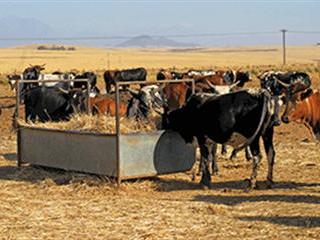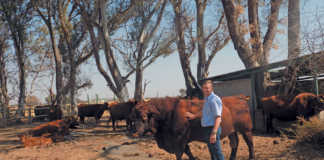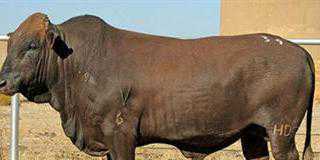
“I bred Angus, Hereford, Charolais and Limousin,” says Piketberg stud breeder, Hannes Eksteen, who ran an Nguni stud and a Limousin stud from 1999 to 2003. “In 2003 and 2004 we had a severe drought here, and then I really saw the difference between the breeds. Heavier animals just don’t cope well in drought due to their high maintenance needs.” After the drought, Hannes sold the Limousin cattle and kept the Ngunis. “I always had an idea they were better suited to our area,” he says.
Different ecotypes
Hannes has always been fascinated by indigenous breeds and now runs representatives of four Nguni ecotypes on his farm. The Sanga from Namibia are taller and larger than the Makatini from northern KZN which are smaller, stockier cattle; the Pedi/Venda type from the old northern Transvaal and the Natal Bartlow type are more the average Nguni. The animals are not separated except during breeding when the bulls are in.

Hannes Eksteen’s only regret is that he didn’t start farming Ngunis sooner.
Strictly controlled genetics
Nguni type cattle are specific to Namibia and South Africa, “So one can’t find new genetics outside these areas, as one can with other breeds,” Hannes explains. “I have to work with what I have and develop my own and new gene pool. I try to keep ahead by not mixing the genetics in the beginning, which keeps each ecotype distinct.
Then I interbreed selected individuals from each, to develop a new gene pool, otherwise I would breed myself into a corner.” The production group, the EX open group, comprises about 80% of his animals, and the other groups are kept pure and in their ecotypes to draw from their gene pools.
Selection process
The selection process starts at weaning, when the calf’s weight in relation to the mother’s weight is used to determine the dam’s milk production. “Very few of the bull calves are ever used for breeding,” says Hannes. “About 90% are slaughtered. I am strict in the selection process, but it’s important in the interest of high standards. I select 10% of the annual bull crop to keep for another year, but those that don’t pass the next selection are also sent to the feedlot to be fattened and slaughtered.”
“When I do my selection I look at temperament first,” says Hannes. “Animals that are anxious or troublesome in the
group are culled, regardless of sex.” The second selection criterion is skin pigment, as areas of pink skin (lack of pigment) are susceptible to sunburn. “I am stricter on bulls, because they would breed this characteristic into the herd very quickly. Where there is only one calf a year from a cow, a bull can sire up to 60 calves.”

The tricolour roan is Hannes’s favourite Nguni colour, but there is no guarantee that a cow of this colour will produce a similar calf.
Thirdly, any physical defect is selected out. Fertility, the fourth criteria, is the most economically important trait to select for.
“I want a heifer to calve at 24 months,” says Hannes, “and then every 12 months for the rest of her breeding life until she is 16 to 18 years old or can no longer keep up with her group. If a cow does not meet these requirements, she is out and on her way to the feedlot. My oldest breeding cow was 21 years old. A cow’s teeth eventually wear out, so that she can’t maintain the physical condition that enables her to conceive.”
Breeding preferences
Hannes aims to breed cows with an average weight of 420kg. “I like a smaller, shorter, stockier animal that does better when conditions are tough. Taller, longer animals are visually attractive but don’t do as well in the dry season and lose condition sooner, which influences reconception. I use 10 to 12 bulls per season, each for a specific reason in corrective mating. On smaller females I use a larger bull and for larger females a smaller bull.
“Animals just above the norm produce the best. If production is too high, longevity suffers.” Hannes explains that nature simply does not give him everything. “A tough breed implies a smaller cow and calf. Everybody tries to select for a cow with longevity, that weans a heavy calf every year, and that eats very little. But it’s impossible. A breeder can select and breed to the best of his ability, but there is a limit to what nature will allow.”
First calves
After weaning, calves are kept close to the homestead for about a month and fed hay so they become used to being handled. “After the first selection they go onto veld for a year. At 15 months, (around June/July) a bull is put into the heifer herd and they calve the following year in April/May, in time for the start of the green season. “We try to keep our ICP (inter-calving period) as short as possible,” says Hannes. “I don’t inseminate because it doesn’t suit my way of farming with minimal labour and low overheads.”
Colour variants
While all the ecotypes have genes for the various colour combinations, the dominant colour in the Makatini herd is black.
When breeding Ngunis, the colour of calves is mostly unpredictable, unless a solid black or red cow and bull are mated in which case the calf is likely to be solid black or red. For other colour variations, the colour of the calf is unknown until it’s born. Multicoloured and tricoloured animals fetch higher prices. Hannes favours the tricolour roan, but this is rarely found.

The Exsteen Nguni stud carries the EX brand on the rump.
Feeding
Every year Hannes plants 100ha oats, of which he mows and bales 80ha for feed during February to May, the difficult months in the Swartland. “Then the dry material on the veld has gone and no rain has yet fallen, so I supplement the diet with hay for four months,” he explains. “When I wean heifers in January, I also provide hay so they maintain their body weight for a higher conception rate when I put them to the bull in June.” For the rest of the year, the Ngunis graze on winter pasture and on wheat stubble in summer.
Management
Hannes explains that before man restricted the movement of animals he did not have to manage them. “They were smart enough to move away from parasite-infected and overgrazed areas. Group pressure, big or small, or old or young wasn’t an issue because there was enough space. Now that animals are enclosed in camps these issues become problematic. The only way to alleviate them is through good management.”
Moving animals regularly, dosing if necessary for parasites and separating animals according to size and age forms part of a good management programme, explains Hannes. “A calving season that coincides with the seasonal fodder flow of my area places less stress on the animals and translates into higher profit.”
Mind shift farming
“The Nguni is easy to farm,” says Hannes, “but you must change your way of thinking if you breed with it. Some breeders have problems with indigenous breeds because they look at the size of the cow and calf, not at the stocking rate on the farm. So determine your land size and the total weight of the calves in kilograms (the production) that you sell off that area.
This determines the cattle operation’s profitability. More calves of a lighter weight outweigh fewer calves that are heavy.”
Ngunis are very low maintenance animals. They tolerate temperatures of over 40°C in full sun, don’t drink much water, and are designed to utilise poor quality roughage. These cattle can control their body temperature by resting in the day and grazing when it’s cooler at night.
Their physical shape and respiration enables Ngunis to keep their body temperatures within limits. The Western Cape has few diseases affecting Ngunis and Hannes admits to having no inoculation programme. “I dose the cattle in April for liver fluke and roundworm, and that’s it.”
Key to good breeding
“For me, observation is the key,” says Hannes. “I must know every specific animal’s best traits so I can select for the best combinations to breed towards my goal. “I know my animals by sight because I spend a lot of time with them. Love and care is important too. Breeding takes time and is demanding, but then nothing in life that’s worthwhile comes easily.”
Selling stock
Heifers between 18 and 24 months that have been running with a bull make up the bulk of sales. However, some buyers want specific animals. His buyers come from far and many are return buyers. To date Hannes has never had enough animals to meet demand.
“Breeding Ngunis is a challenging and rewarding occupation. The colour of a calf is almost always an exciting surprise. With Ngunis, colour is an additional trait I must keep in mind. In other cattle, breeders don’t have to worry about colour.” Hannes runs three Nguni studs: Exsteen Ngunis, Select AZ Ngunis and Makatini Ngunis.
For more information visit www.ngunicattle.net













